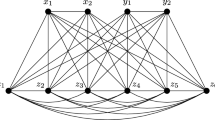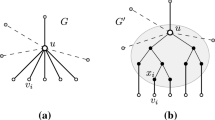Abstract
We investigate the complexity of finding a transformation from a given spanning tree in a graph to another given spanning tree in the same graph via a sequence of edge flips. The exchange property of the matroid bases immediately yields that such a transformation always exists if we have no constraints on spanning trees. In this paper, we wish to find a transformation which passes through only spanning trees satisfying some constraint. Our focus is bounding either the maximum degree or the diameter of spanning trees, and we give the following results. The problem with a lower bound on maximum degree is solvable in polynomial time, while the problem with an upper bound on maximum degree is PSPACE-complete. The problem with a lower bound on diameter is NP-hard, while the problem with an upper bound on diameter is solvable in polynomial time.


























Similar content being viewed by others
Notes
Formally, we perturb the length by defining \(\ell (e)\) as the vector \((1, \chi _{i(e)}) \in {\mathbb {R}} \times {\mathbb {R}}^{|E|}\), where \(\chi _{j} \in {\mathbb {R}}^{|E|}\) is the characteristic vector of \(\chi _{j}\) (see e.g., [3]). Then, we use the lexicographical order to compare the lengths of paths. With this notation, for \(\alpha \in {\mathbb {R}} \times {\mathbb {R}}^{|E|}\), we can formally define \({\bar{\alpha }} \in {\mathbb {R}}\) as the first coordinate of \(\alpha \). However, to simplify the notation, we define \(\ell (e)\) as a real number in this paper.
More precisely, if \(e_1\) and \(e_2\) share an end vertex, then \(b_\top \) (resp. \(b_\bot \)) may be contained in \(e_1\) or \(e_2\). In such a case, \({V_\top } \subseteq V\) (resp. \({V_\bot } \subseteq V\)) is defined as the vertex set of the connected component of \(Q-\left\{ e_1, e_2\right\} \) that does not contain \(b_\bot \) (resp. \(b_\top \)).
References
Barjon, M., Casteigts, A., Chaumette, S., Johnen, C., Neggaz, Y.M.: Maintaining a spanning forest in highly dynamic networks: the synchronous case. In: Marcos K., Aguilera, L.Q., Marc S., (eds.) Principles of Distributed Systems, pp. 277–292. Springer International Publishing, Cham (2014)
Bousquet, N., Ito, T., Kobayashi, Y., Mizuta, H., Ouvrard, P., Suzuki, A., Wasa, K.: Reconfiguration of spanning trees with many or few leaves. In: 28th Annual European Symposium on Algorithms, ESA 2020, September 7-9, 2020, Pisa, Italy (Virtual Conference), pp. 24:1–24:15 (2020). https://doi.org/10.4230/LIPIcs.ESA.2020.24
Cabello, Sergio, Chambers, Erin W., Erickson, Jeff: Multiple-source shortest paths in embedded graphs. SIAM J. Comput. 42(4), 1542–1571 (2013). https://doi.org/10.1137/120864271
Czumaj, A., Strothmann, WB.: Bounded degree spanning trees. In: Rainer, B., Gerhard, W., (eds.) Algorithms — ESA ’97, Vol. 1284 of LNCS, pp. 104–117. Springer Berlin Heidelberg, Berlin Heidelberg (1997)
Furer, Martin, Raghavachari, Balaji: Approximating the minimum-degree steiner tree to within one of optimal. J. Algorithms 17(3), 409–423 (1994). https://doi.org/10.1006/jagm.1994.1042
Goemans, MX.: Minimum bounded degree spanning trees. In 47th Annual IEEE Symposium on Foundations of Computer Science (FOCS 2006), 21-24 October 2006, Berkeley, California, USA, Proceedings, pp. 273–282. IEEE Computer Society. https://doi.org/10.1109/FOCS.2006.48 (2006)
Hassin, R., Levin, A.: Minimum restricted diameter spanning trees. Discret. Appl. Math. 137(3), 343–357 (2004). https://doi.org/10.1016/S0166-218X(03)00360-3
Hassin, Refael, Tamir, Arie: On the minimum diameter spanning tree problem. Inf. Process. Lett. 53(2), 109–111 (1995). https://doi.org/10.1016/0020-0190(94)00183-Y
Hearn, Robert A., Demaine, Erik D.: PSPACE-completeness of sliding-block puzzles and other problems through the nondeterministic constraint logic model of computation. Theor. Comput. Sci. 343(1–2), 72–96 (2005). https://doi.org/10.1016/j.tcs.2005.05.008
van den Heuvel, J.: The complexity of change. In: Simon, R., Blackburn, S.G., Mark W. (eds.)Surveys in Combinatorics, Vol. 409 of London Mathematical Society Lecture Note Series, pp. 127–160. Cambridge University Press (2013). https://doi.org/10.1017/CBO9781139506748.005
Huang, S., Fu, AWC., Liu, R.: Minimum spanning trees in temporal graphs. In Proceedings of the 2015 ACM SIGMOD International Conference on Management of Data, SIGMOD ’15, pp 419-430, New York, NY, USA, (2015). Association for Computing Machinery. https://doi.org/10.1145/2723372.2723717
Italiano, Giuseppe F., Ramaswami, Rajiv: Maintaining spanning trees of small diameter. Algorithmica 22(3), 275–304 (1998). https://doi.org/10.1007/PL00009225
Ito, T., Demaine, E., Harvey, N.J.A., Papadimitriou, C.H., MarthaSideri, R., Uno, Y.: On the complexity of reconfiguration problems. Theor. Comput. Sci. 412(12), 1054–1065 (2011). https://doi.org/10.1016/j.tcs.2010.12.005
Karp, R. M.: Reducibility among combinatorial problems. In: Miller, R., Thatcher, J. (eds) Complexity of Computer Computations, pp. 85–103. Plenum Press (1972)
Korte, B. H., Vygen, J.: Combinatorial Optimization: Theory and Algorithms. Springer-Verlag, New York, NY, (2012). https://doi.org/10.1007/978-3-642-24488-9
Mizuta, H., Hatanaka, T., Ito, T., Zhou, X.: Reconfiguration of minimum steiner trees via vertex exchanges. In: 44th International Symposium on Mathematical Foundations of Computer Science, MFCS 2019, August 26-30, 2019, Aachen, Germany, pp. 79:1–79:11, (2019). https://doi.org/10.4230/LIPIcs.MFCS.2019.79
Nishimura, Naomi: Introduction to reconfiguration. Algorithms 11(4), 52 (2018). https://doi.org/10.3390/a11040052
Schrijver, A.: Combinatorial Optimization—Polyhedra and Efficiency. Springer (2003)
Singh, M., Lau, L. C.: Approximating minimum bounded degree spanning trees to within one of optimal. J. ACM, 62(1), (March 2015). https://doi.org/10.1145/2629366
Spriggs, M.J., Keil, J.M., Bespamyatnikh, S., Segal, M., Snoeyink, J.: Computing a \((1+\varepsilon )\)-approximate geometric minimum-diameter spanning tree. Algorithmica 38(4), 577–589 (2004). https://doi.org/10.1007/s00453-003-1056-z
Takaoka, A.: Complexity of Hamiltonian cycle reconfiguration. Algorithms 11(9), 140 (2018). https://doi.org/10.3390/a11090140
Funding
This work is partially supported by JSPS and MEAE-MESRI under the Japan-France Integrated Action Program (SAKURA). Nicolas Bousquet was supported by ANR project GrR (ANR-18-CE40-0032). Takehiro Ito is partially supported by JSPS KAKENHI Grant Numbers JP18H04091, JP19K11814 and JP20H05793, Japan. Yusuke Kobayashi is partially supported by JSPS KAKENHI Grant Numbers JP18H05291, JP20K11692, and JP20H05795, Japan. Paul Ouvrard was supported by ANR project GrR (ANR-18-CE40-0032). Akira Suzuki is partially supported by JSPS KAKENHI Grant Numbers JP18H04091, JP20K11666 and JP20H05794, Japan. Kunihiro Wasa is partially supported by JST CREST Grant Numbers JPMJCR18K3 and JPMJCR1401, and JSPS KAKENHI Grant Numbers JP19K20350 and JP20H05793, Japan.
Author information
Authors and Affiliations
Corresponding author
Ethics declarations
Conflict of interest
The authors have no relevant financial or non-financial interests to disclose.
Additional information
Publisher's Note
Springer Nature remains neutral with regard to jurisdictional claims in published maps and institutional affiliations.
Rights and permissions
Springer Nature or its licensor (e.g. a society or other partner) holds exclusive rights to this article under a publishing agreement with the author(s) or other rightsholder(s); author self-archiving of the accepted manuscript version of this article is solely governed by the terms of such publishing agreement and applicable law.
About this article
Cite this article
Bousquet, N., Ito, T., Kobayashi, Y. et al. Reconfiguration of Spanning Trees with Degree Constraints or Diameter Constraints. Algorithmica 85, 2779–2816 (2023). https://doi.org/10.1007/s00453-023-01117-z
Received:
Accepted:
Published:
Issue Date:
DOI: https://doi.org/10.1007/s00453-023-01117-z




